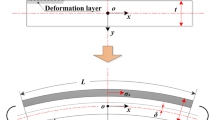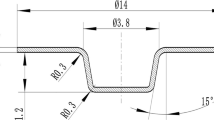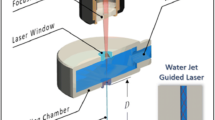Abstract
Based on the advantages of laser shock forming, such as high-speed dynamic loading, good filling ability of die cavity, and improving material formability along with its other advantages of warm forming to improve forming discreteness and further develop formability, a warm laser shock micro-heading forming (WLSMHF) method was investigated, and an experimental system was established. Combining ALE method in ABAQUS with experiment, the feasibility was studied with T2 copper. The propagation of stress wave, deformation process, and material flow law was studied. The influence of laser energy, temperature, and grain size on the deformation of upsetting head was studied. The influence of forming temperature and grain size on forming discreteness was analyzed. Results show that the phenomenon of the anti-Taylor anvil impact test first appears in the whole rod. When the inside of the die is filled with material, the deformation of the material outside the die is similar to that of micro-upsetting. The upper end of the upsetting head is slightly larger than the lower end because of the propagation of stress wave, inertia effect, and the restraint of the die to the material. The flow speed of the metal material in the die is fast, the die is filled well, and the filling property of the die is good. The deformation of upsetting head increases with the laser energy and temperature, which improves the formability of the material. The deformation of the upsetting head increases with the grain size, and the effect of grain size on forming can be reduced by increasing the forming temperature simultaneously. The increase in the forming temperature and decrease in the grain size can improve the discreteness of the forming size and forming accuracy, respectively.



























Similar content being viewed by others
Change history
22 January 2022
A Correction to this paper has been published: https://doi.org/10.1007/s00170-022-08707-1
References
Fu MW, Chan WL (2013) A review on the state-of-the-art microforming technologies. Int J Adv Manuf Tech 67:2411–2437. https://doi.org/10.1007/s00170-012-4661-7
Fu MW, Chan WL (2014) Micro-scaled products development via microforming. Springer Berlin. https://doi.org/10.1007/978-1-4471-6326-8
Cheng GJ, Pirzada D, Ming Z (2007) Microstructure and mechanical property characterizations of metal foil after microscale laser dynamic forming. J Appl Phys 101:345–360. https://doi.org/10.1063/1.2710334
Zheng C, Tian ZR, Zhao XH, Tan YC, Zhang GF, Zhao GQ, Ji Z (2020) Effect of pulsed laser parameters on deformation inhomogeneity in laser shock incremental forming of pure copper foil. Opt Laser Technol 127:106205. https://doi.org/10.1016/j.optlastec.2020.106205
Tobias SA (1984) The state of the art of high energy rate bulk forming. J Mech Work Technol 9:237–277. https://doi.org/10.1016/0378-3804(84)90108-6
Liu HX, Hu Y, Wang X, Shen ZB, Li P, Gu CX, Liu H, Du DZ, Guo C (2013) Grain refinement progress of pure titanium during laser shock forming (LSF) and mechanical property characterizations with nanoindentation. Mat Sci Eng a-Struct 564:13–21. https://doi.org/10.1016/j.msea.2012.11.087
Wang KY, Liu HX, Ma YJ, Lu JZ, Wang X, Lu JX, Gu X, Zhang HK (2021) Laser shock micro-bulk forming: numerical simulation and experimental research. J Manuf Process 64:1273–1286. https://doi.org/10.1016/j.jmapro.2021.02.049
Egerer E, Engel U (2004) Process characterization and material flow in microforming at elevated temperatures. J Manuf Process 6:1–6. https://doi.org/10.1016/S1526-6125(04)70054-7
Egerer E, Engel U (2003) Material behavior in microforming at elevated temperature
Engel U, Egerer E (2003) Basic research on cold and warm forging of microparts. Key Eng Mat 233(2):449–455. https://doi.org/10.4028/www.scientific.net/KEM.233-236.449
Yang HF, Xiong F, Liu K, Man JX, Chen HX, Liu H, Hao JB (2019) Research on temperature-assisted laser shock imprinting and forming stability. Opt Laser Eng 114:95–103. https://doi.org/10.1016/j.optlaseng.2018.11.002
Ye C, Cheng GJ (2010) Effects of temperature on laser shock induced plastic deformation: The case of copper. J Manuf Sci E-T Asme 132. https://doi.org/10.1115/1.4002849
Mishra A, Martin M, Thadhani NN, Kad B, Meyers MA (2008) High-strain rate response of ultrafine grained copper: Experiments and analysis. Acta Mater. https://doi.org/10.1016/j.actamat.2008.02.023
Lin T, Chen Z, Zhan C, Yang X, Liu C (2013) Microstructure and microtexture evolution of shear localization in dynamic deformation with different strains in annealed copper. Metall Mater Trans A-Phys Metall Mater Sci 44:793–805. https://doi.org/10.1007/s11661-012-1421-0
Johnson GR, Cook WH (1983) A constitutive model and data for metals subjected to large strains, high strain rates and high temperatures. Eng Fract Mech 21:541–548
Wu SL, Ju K, Duan CZ, Kong JX (2019) Dynamic mechanical properties and constitutive model of fine-grained T2 copper. Tool Eng 53:16–20. https://doi.org/10.3969/j.issn.1000-7008.2019.11.004
Peyre P, Fabbro R (1995) Laser shock processing: A review of the physics and applications. Opt Quantum Electron 27:1213–1229. https://doi.org/10.1007/BF00326477
Fabbro R, Fournier J, Ballard P, Devaux D, Virmont J (1990) Physical study of laser-produced plasma in confined geometry. J Appl Phys 68:775–784. https://doi.org/10.1063/1.346783
Clifton RJ (1985) Stress wave experiments in plasticity. Int J Plast 1:289–302. https://doi.org/10.1016/0749-6419(85)90016-6
Wang J, Cheng L (2008) Effect of material parameters on stress wave propagation during fast upsetting. Trans Nonferrous Met Soc China 18:1189–1195. https://doi.org/10.1016/S1003-6326(08)60203-4
Eakins D, Thadhani NN (2007) Analysis of dynamic mechanical behavior in reverse Taylor anvil-on-rod impact tests. Int J Impact Eng 34:1821–1834. https://doi.org/10.1016/j.ijimpeng.2006.11.001
Zhang X, Zhang MY, Sun LQ, Li CF (2018) Numerical simulation and experimental investigations on TA1 titanium alloy rivet in electromagnetic riveting. Arch Civ Mech Eng 18:887–901. https://doi.org/10.1016/j.acme.2018.01.003
Nemat-Nasser S, Li Y (1998) Flow stress of f.c.c. polycrystals with application to OFHC Cu. Acta Mater 46:565–577. https://doi.org/10.1016/S1359-6454(97)00230-9
Wang CJ, Guo B, Shan DB, Sun LN (2009) Effects of specimen size on flow stress of micro rod specimen. Trans Nonferrous Met Soc China 19:S511–S515. https://doi.org/10.1016/S1003-6326(10)60099-4
Funding
The work reported in this paper was supported by the National Natural Science Foundation of China (No.52075226).
Author information
Authors and Affiliations
Contributions
Qifan Gong wrote the first draft of the paper. All authors revised and approved the final version of the manuscript.
Corresponding author
Ethics declarations
Ethics approval
Not applicable.
Consent to participate
Not applicable.
Consent to publish
Not applicable.
Conflict of interest
The authors declare no competing interests.
Additional information
Publisher's Note
Springer Nature remains neutral with regard to jurisdictional claims in published maps and institutional affiliations.
The original online version of this article was revised: Figure 6 is incorrect.
Rights and permissions
About this article
Cite this article
Gong, Q., Wang, X., Zhang, T. et al. Warm laser shock micro-heading forming (T2 copper): numerical simulation and experimental research. Int J Adv Manuf Technol 119, 1491–1511 (2022). https://doi.org/10.1007/s00170-021-08334-2
Received:
Accepted:
Published:
Issue Date:
DOI: https://doi.org/10.1007/s00170-021-08334-2




